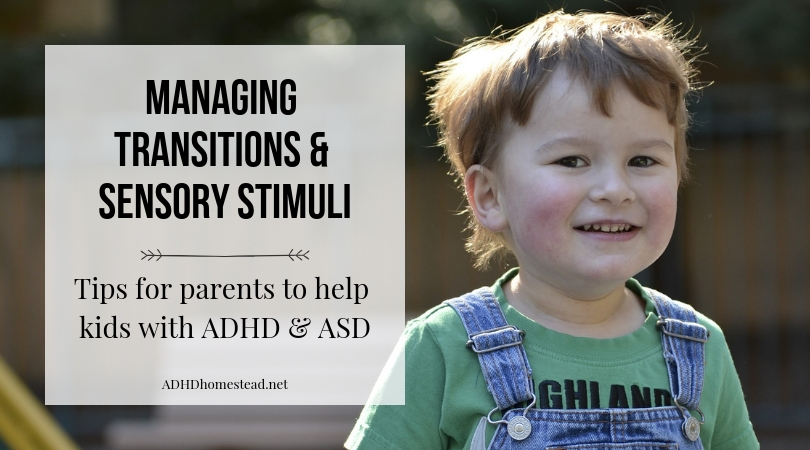This is a guest post from Jenny Wise of Special Home Educator. The topics she addresses here cover one area of frequent overlap between children with autism and ADHD. I hope you find it enlightening!
Even a simple daily activity like boarding the school bus can be intensely upsetting for a child with ADHD or autism. These reactions can feel unpredictable to a frazzled parent, especially when your child encounters an unfamiliar routine or situation for the first time. The more you understand and can recognize how anxiety affects your child and how they respond to transitions and sensory stimuli, the more prepared you will feel when trying to mitigate an upset reaction.

Be mindful of difficult transitions.
Students with autism and ADHD can find the school environment itself very challenging. Your child may feel overwhelmed by the noise and activity of so many classmates in an enclosed space. Transitions throughout the school day only increase stress.
During enjoyable activities, your child may sink into hyperfocus. Moving directly from an action he enjoys to one he doesn’t can feel upsetting and unexpected. It’s important to understand this and provide support during transitions. Try asking your child’s teacher about daily schedules so you can prepare visual reminders of classroom routines and expected changes throughout the day. This could include a photo of the event with the time it takes place.
Having a visual schedule your child can refer to can make these transitions easier. Eventually, she’ll learn to expect them and make the adjustment. You may even choose to take a picture of her making a successful transition from one activity to the next. This positive reinforcement illustrates her ability to handle transitions and gives her something tangible to refer to.
Teach appropriate relaxation strategies.
Children with ADHD and autism can struggle with anxiety, whether it’s school-based or of a more generalized social variety. They may need help finding relaxation techniques that work for them.
Meditation has been proven effective in helping autistic children cope with anxiety-producing situations they face in school. It’s a calming, self-regulating discipline, and children need to be shown how to make it effective. That may prove difficult for younger children, who often lack the patience and self-discipline to make it work. If meditation proves too difficult for your child, deep-breathing exercises are simpler and may prove more successful. It’s a soothing activity that a child can do anywhere, anytime he feels anxious about something.
Watch for sensory processing issues.
According to the STAR Institute, 75 percent of autistic children exhibit notable symptoms of sensory processing disorder. Many children with ADHD seem to experience this as well. Children may manifest this dysfunction in many ways, from overt sensory aversion behavior to an inability to interact with certain people or physical objects. Fortunately, there are a number of effective strategies to help children cope with sensory processing problems.
If noise is a trigger, noise-cancelling headphones may help during noisier periods at school and at home. In some cases, you may need to integrate a child into a challenging environment slowly, with the goal of helping her adapt through incremental and repeated exposure.
For kids who struggle with visual stimuli, ask the teacher to limit visual clutter in the classroom. Do the same in your home. Consider placing labels with pictures on containers, or use pictures to illustrate where your child should keep specific items in their desk or bedroom.
Help your child get a good night’s sleep.
Sleep is critical to help us cope with difficult social situations and small challenges that arise throughout the day. It’s no different for children with autism and ADHD, for whom these challenges may feel especially overwhelming. In fact, lack of sleep can actually produce ADHD-like symptoms in neurotypical children. If you want to help a child with autism or ADHD develop effective coping strategies, a good night’s sleep should be the first step.
Your child will benefit from a familiar nighttime routine that helps them get to sleep. For many children, sleep is yet another difficult transition. It becomes harder still if the child is engaged in a very enjoyable activity just before he is asked to get into bed. A nighttime routine that takes this into account can help ease the transition.
If sleep is a consistent problem, consider the possible role of sensory sensitivities. For example, an old, uncomfortable can inhibit sleep. If your child’s mattress is more than a decade old, it probably needs replacing. Some children are also very sensitive to the weight and texture of their sheets. An itchy pajama tag can feel unbearable. Even something like the color of their bedroom walls can create inner turmoil and wakefulness. Don’t dismiss these preferences as picky behavior. Any of these seemingly minor issues can affect a child’s sleep enough to cause problems that cascade throughout the school day.
While it may help to introduce a child into a difficult environment gradually, you also may need other interventions to help him cope. Getting to know your child’s anxiety triggers and sensory dislikes will enable you to anticipate and manage negative responses. Sometimes a simple intervention can make a big difference.
Hey there! Are you enjoying The ADHD Homestead?
Here's the thing: I don't like ads. I don't want to sell your attention to an advertising service run by the world's biggest data mining company. I also value my integrity and my readers' trust above all, which means I accept very few sponsorships/partnerships.
So I'm asking for your support directly. For the cost of one cup of coffee, you can help keep this site unbiased and ad-free.
Below you will find two buttons. The first lets you join our crew of Patreon pals and pledge monthly support for my work. Patrons also have access to my Audioblogs podcast. The second takes you to a simple donation page to pledge one-time or recurring support for The ADHD Homestead, no frills, no strings. Do whichever feels best for you!

